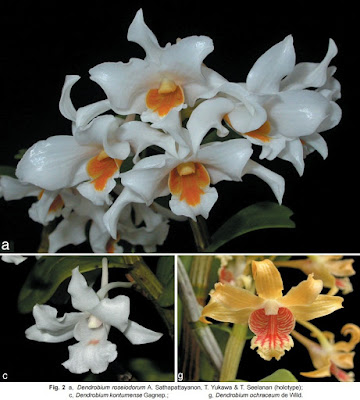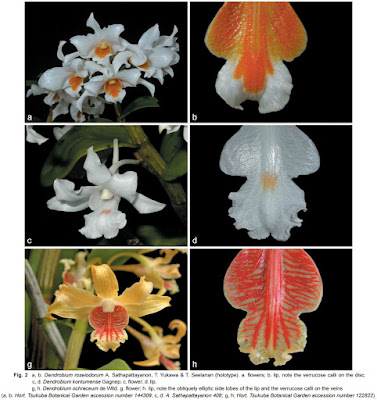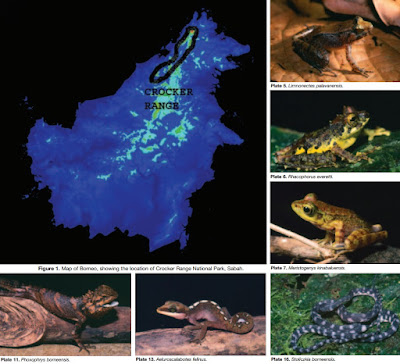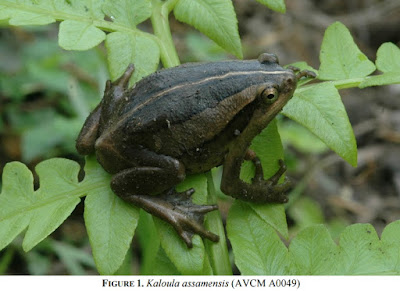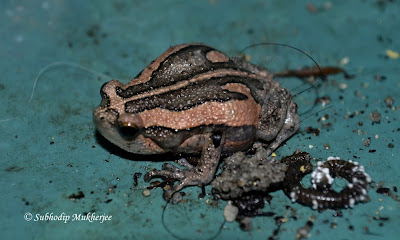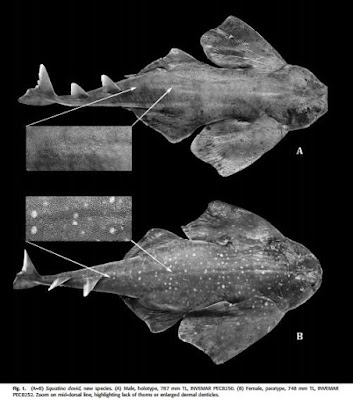[Most Recent Entries] [Calendar View]
Thursday, July 14th, 2016
| Time | Event | ||
| 2:20p | [Botany • 2010] Dendrobium roseiodorum • A New Species (Orchidaceae) from Vietnam
Abstract In the course of revisionary work of Dendrobium section Formosae, we found some misinterpretations of Dendrobium kontumense. Dendrobium schildhaueri is placed as a synonym of D. kontumense and Dendrobium roseiodorum, a new species from Vietnam, is described. Key words: Dendrobium roseiodorum, new species, Orchidaceae, Vietnam Dendrobium roseiodorum A.Sathapattayanon, T.Yukawa & T.Seelanan, sp. nov.— Fig. 1, 2a, b Dendrobium ochraceum de Wild. affine, sed petalis ellipticis-rhombicis, labello aureo-aurantiaco, et disco labelli verrucoso diversum. — Typus: Hort. Tsukuba Botanical Garden accession number 118269 (holo TNS; iso BCU), Vietnam, sine loc., 15 September 2008. Dendrobium kontumense auct. non. Gagnep.; Schildhauer (2002) 369; Vestweber (2004) 38; Yukawa (2004) 23, f. 3–4. Distribution — Vietnam (Khanh Hoa Province and Lâm Dong Province). Habitat & Ecology — Recorded on boulders or tree branches; 1000–1200 m altitude. Flowering: September to November (in natural habitat), July to December (in cultivation). Etymology — The specific epithet refers to the rose-like floral scent of the new species. A. Sathapattayanon, T. Yukawa andT. Seelanan. 2016. Dendrobium roseiodorum (Orchidaceae): A New Species from Vietnam. Blumea. 55; 75–79. DOI: 10.3767/000651910X499240   | ||
| 3:10p | [Herpetology • 2006] Crocker Range National Park, Sabah, as A Refuge for Borneo’s Montane Herpetofauna Abstract Crocker Range National Park in Sabah (East Malaysia), northern Borneo, is an exceptional area for herpetological diversity. Inventories of the Park are incomplete, but show high diversity, as well as regional endemicity shared with the adjacent and more well-known Gunung Kinabalu National Park. The montane ecosystem of the Range offers refuge for a number of rare herpetofaunal taxa, including Stoliczkia borneensis, Rhabdophis murudensis, Oligodon everetti, Philautus bunitus, Ansonia anotis, Sphenomorphus aesculeticola, and undescribed species of squamates of the genera Sphenomorphus and Gongylosoma. The 59 species of amphibians and 45 species of reptiles now recorded from the Range represent 39 and 16.2 per cent of the total Bornean amphibian and reptile fauna, respectively. The high levels of deforestation of the surrounding regions of Borneo, particularly lowland rainforests, highten the importance of protection of primary forests of northern Borneo’s Crocker Range. Key words. Crocker Range National Park, Sabah, Malaysia, herpetofauna, conservation Indraneil Das. 2006. Crocker Range National Park, Sabah, as A Refuge for Borneo’s Montane Herpetofauna. Amphibian and Reptile Conservation. 4(1):3-11. DOI: 10.1514/journal.arc.0040015 http://amphibian-reptile-conservation.or | ||
| 3:42p | [Herpetology • 2004] Kaloula assamensis • A New Species of Kaloula (Anura: Microhylidae) from Assam State, north-eastern India
Abstract A new species of microhylid of the genus Kaloula is described from Assam and Arunachal Pradesh states, north-east India. Kaloula assamensis new species, is compared with congeners from south and south-east Asia. The new species is diagnosablein showing the following combination of characters: SVL up to 38.0 mm; tympanum notexternally visible; choanae rounded, moderately large, at anterolateral edge of palate,separated by a distance greater than twice their length; postnarial ridges across palatenot curving backwards towards inner edge of choanae; finger tips slightly dilated; subarticular tubercles prominent, rounded; webbing on pes to level of distal subarticular tubercles, except on toe IV, where it is to the medial tubercle, reaching tips of all toes asa narrow sheath; toe tips slightly rounded; supernumerary tubercle at base of each digitof manus; tarsus smooth, lacking folds; supratympanic fold extends from posterior edgeof eye to above insertion of forelimbs; lateral glandular flank ridge absent; abdomen coarsely granular; pale brown dorsally, with a dark-edged bright yellow vertebral stripe,commencing from tip of snout and terminating near vent, where it becomes less distinct;a dark-edged broad dark brown lateral stripes, commencing from the postocular region,and extending to inguinal region; stratified colouration on posterior face of thighs and flanks; and light pericloacal ring present. Keywords: Kaloula, new species, Kaloula assamensis, Microhylidae, systematics, new species, India. Diagnosis.- A small (SVL up to 38.0 mm) species of Kaloula, diagnosable from congeneric species in showing the following combination of characters: tympanum not externally visible; choanae rounded, moderately large, at antero-lateral edge of palate, separated by a distance greater than twice their length; postnarial ridges across palate not curving backwards towards inner edge of choanae; finger tips slightly dilated; subarticular tubercles prominent, rounded; webbing on pes to level of distal subarticular tubercles, except on toe IV, where it is to the medial tubercle, reaching tips of all toes as a narrow sheath; toe tips slightly rounded; supernumerary tubercle at base of each digit of manus; tarsus smooth, lacking folds; supratympanic fold ex-tends from posterior edge of eye to above insertion of forelimbs; lateral glandular flank ridge absent; abdomen coarsely granular; pale brown dorsally, with a dark-edged bright yellow vertebral stripe, commencing from tip of snout and terminating near vent, where it becomes less distinct; a dark-edged broad dark brown lateral stripes, commencing from the postocular region,and extending to inguinal region; stratified colouration on posterior face of thighs and flanks;and light pericloacal ring present. Natural History Notes The holotype of the new species was unearthed in a field of mustard (Brassica juncea). The Nameri paratype was found sitting on an herba-ceous plant, ca. 0.3 m above substrate, at 1830h, within an evergreen forest. Other amphibian species found in sympatry with the new speciesat this site include Megophrys parva, Rana humeralis, R. leptoglossa, Fejervarya aff. limnocharis, Microhyla ornata and Uperodon globulosum. The Sirajuli paratype was found under herbaceous moist vegetation. The eggs, larvae stages and call of the new species remain un-known. The two Orang paratypes were collected during the post-monsoon season, while sittingon blades of the grass Saccharum spp., ca. 1 mabove ground. Seven other species of anurans (including the type series of Kalophrynus orangensis Dutta et al., 2000) were found at this lo-cality. The Pakhui paratype was collected froma fern within a waterlogged area, while sitting ata height of ca. 0.6 m above substrate, at 1920 h.In sympatry were Chirixalus simus, C. vittatus, Polypedates leucomystax and Rana humeralis. Das, I., Sengupta, S., Ahmed, M.F. and Dutta, S.K. 2004. A New Species of Kaloula (Anura: Microhylidae) from Assam State, north-eastern India. Hamadryad. 101-109. Saibal Sengupta, Abhijit Das, Sandeep Das, Balhtiar Hussain, Nripendra Kumar Choudhury and Sushil Kumar Dutta. 2009. Taxonomy and Biogeography of Kaloula Species of Eastern India. The Natural History Journal of Chulalongkorn University. 9(2): 209-222. http://www.biology.sc.chula.ac.th/TNH/ar Anukul Nath, Firoz Ahmed and Hilloljyoti Singha. 2011. Record of Kaloula assamensis (Das et al., 2004) (Anura: Microhylidae) from Bongagaon District, Assam, India. frog leg [Newsletter of the Amphibian Network of South Asia and Amphibian Specialist Group - South Asia]. 17. | ||
| 4:44p | [Ichthyology • 2016] Squatina david • A New Southern Caribbean Species of Angel Shark (Chondrichthyes, Squaliformes, Squatinidae), Including Phylogeny and Tempo of Diversification of American Species
A new species of Squatina, S. david, is described from the Colombian Caribbean. The new species differs from all the western North Atlantic angel sharks by lacking a mid-dorsal line of thorns or enlarged dermal denticles, by having an eye-spiracle distance larger than 1.5 times eye diameter, and each nasal flap with two rod-like barbels. Coloration is grayish to brownish yellow, males are dark-spotted, females have abundant whitish spots. Squatina david is nested within the American clade of angel sharks, being the sister species to the Brazilian species. Arturo Acero P., José J. Tavera, Rafael Anguila and Luis Hernández. 2016. A New Southern Caribbean Species of Angel Shark (Chondrichthyes, Squaliformes, Squatinidae), Including Phylogeny and Tempo of Diversification of American Species. Copeia. 104(2):577-585. DOI: 10.1643/CI-15-292 Se describe a Squatina david n. sp. del Caribe colombiano. La nueva especie se distingue de las otras especies de peces ángel del Atlántico noroccidental por carecer de una línea media dorsal de espinas o dentículos dérmicos agrandados y por tener una distancia del ojo al espiráculo mayor que 1.5 el diámetro del ojo en especímenes de más de 60 cm de longitud total, cada pliegue nasal con dos barbillones romos y una coloración amarillo grisoso a marrón, macho con puntos oscuros, hembras con abundantes puntos blancos. La nueva especie se agrupa con el clado americano de peces ángel, siendo hermana del clado de especies brasileras. |
| << Previous Day |
2016/07/14 [Calendar] |
Next Day >> |
